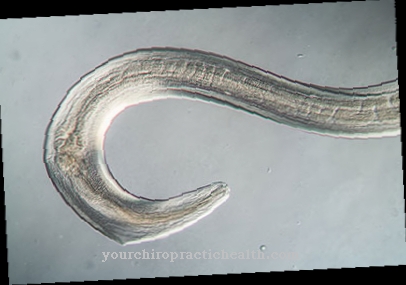Scarlet fever is mostly a childhood disease that is transmitted by streptococcal bacteria. Typical signs of scarlet fever are a rash on the tongue, cough, sputum, runny nose and fever. Most of the time, scarlet fever is transmitted through droplet infection or direct contact.
What is scarlet fever

© Lukassek - stock.adobe.com
Scarlet fever was a well-known and previously widespread childhood disease. Today it is not so common anymore. It is caused by strep bacteria, which can also be responsible for other diseases. These include tonsillar angina, tonsillitis, and sore throat. Scarlet fever can also be the cause of secondary diseases such as rheumatic fever.
Scarlet fever occurs mostly in kindergarten and school children and spreads among them through contact infection. Interestingly, babies up to the sixth month have a natural immune protection against scarlet fever and other childhood diseases. But adults can also get scarlet fever. Seasonally, the risk of infection is highest between October and March.
If scarlet fever occurs, this disease must be reported to the doctor immediately in order to avoid further infection.
causes
The cause of Scarlet fever is an infection with streptococcal bacteria (also A-streptococci, Streptococcus pyogenes). The bacteria are transmitted either through direct contact with an infected person or through droplet infection (coughing, runny nose). Infected foods, beverages and objects can also be considered sources of infection.
Scarlet fever breaks out within one to three days after infection and the symptoms appear as typical symptoms. Those affected can infect other people, so isolation and treatment are absolutely necessary.
Symptoms, ailments & signs
The first symptom of the disease is suddenly a sore throat. They are accompanied by more severe swallowing difficulties and often a very high fever of up to 40 ° C. Headache and nausea with vomiting also occur. Patients often complain of abdominal pain and a poor general condition. They feel exhausted and tired, sometimes they have chills.
On the second day of the disease, the throat shows the typical red discoloration, the tongue is covered with pus and the lymph nodes on the neck are swollen. The tonsils are enlarged, reddened and covered with pus. In addition, a rash with pinhead-sized dots forms at the time.
This velvety and non-itchy rash begins on the chest, sometimes in the groin, and spreads over the whole body. It is most intense in the groin and on the inside of the thighs. The only place left by the rash is the triangular area between the mouth and chin.
After three to four days, the white coating on the tongue loosens and is shed. The inflamed and swollen papillae become visible and cause the tongue's typical raspberry-like appearance. The so-called raspberry tongue is considered a characteristic symptom of scarlet fever. After two to four weeks, the rash will go away and the skin will peel off in scales.
Course of disease

An untreated disease course of Scarlet fever can cause immense damage. Above all, it can lead to poisoning of various organs, circulatory failure, diarrhea, heart muscle inflammation and vomiting. The streptococcal bacteria can also spread with the bloodstream and subsequently lead to blood poisoning (sepsis). Sinusitis and meningitis are also possible.
The long-term consequences of scarlet fever are heart valve defects, kidney diseases and rheumatic fever. Pregnant women suffering from scarlet fever do not leave any lasting damage to the unborn child.Children infected with scarlet fever who have been treated with antibiotics can go back to school or kindergarten after a few days.
Complications
Nowadays, serious consequential damage from scarlet fever is rarely to be feared, which is due to the use of antibiotic drugs. However, there is danger if the infection is left untreated. In such cases, there is a risk of secondary streptococcal diseases such as rheumatic fever, rheumatic endocarditis or post-streptococcal glomerulonephritis. They are among the immunological diseases.
They are caused by the immune reaction of the immune system, which is directed against the germs that cause the scarlet fever disease. They show up around four to six weeks after infection. Streptococcal infections are also suspected to cause neuropsychiatric autoimmune diseases.
This can be chorea minor, Tourette's syndrome, or PANDAS. If the pathogens penetrate the bloodstream, there is also the threat of a dangerous toxic shock syndrome (TSS), which leads to severe organ and circulatory failure caused by the toxins of the bacteria.
Not infrequently, the streptococci are responsible for other secondary diseases of the scarlet fever infection. These purulent complications occur after the scarlet fever has healed. These are often inflammations of the paranasal sinuses, acute otitis media, meningitis or streptococcal sepsis.
Furthermore, the formation of abscesses on the connective tissue of the tonsils is possible. The risk of scarlet fever complications is particularly pronounced in adult patients. Those affected usually try self-therapy first instead of going to a doctor quickly.
When should you go to the doctor?
Rising fever and the characteristic red color of the throat and tongue suggest scarlet fever. The child should be presented to a doctor if symptoms appear to appear overnight and do not resolve within a few hours. If the lymph nodes in the neck also swell or accompanying symptoms such as abdominal pain and discomfort, it is best to consult a doctor immediately. An immediate doctor's visit is also indicated if the child has a streptococcal infection in the kindergarten or school.
Adults who notice these symptoms should consult their family doctor as soon as possible. Other contact points are the dermatologist or an internist. If scarlet fever is treated early, it should subside within a few days. A very high fever and increased gastrointestinal complaints indicate a complicated course of the disease. If the patient's condition does not improve despite bed rest and drug treatment, inpatient treatment may be required. The family doctor or pediatrician should be informed immediately about persistent symptoms and complaints.
Treatment & Therapy
The regular treatment of Scarlet fever takes place through antibiotics (penicillin). In any case, a doctor should be consulted in the case of scarlet fever, because on the one hand there is an obligation to report and on the other hand, self-treatment is urgently not recommended. Above all, the unpleasant symptoms of illness, such as cough, headache, sore throat, fever and body aches, should be alleviated and the streptococcal bacteria eliminated.
If the person concerned is intolerant to the antibiotic medication or is allergic to them, the doctor can prescribe alternatives such as cephalosporin, roxithromycin or erythromycin. In addition to the general initial examination, a second examination should be carried out by the doctor after one to two weeks. A urine sample is usually taken and examined here. The aim is to determine whether a so-called kidney corpuscle inflammation has developed in the body or in the urine. You should also watch out for blood residues in the urine.
In addition to the medical examination and treatment, the person affected with scarlet fever should definitely keep strict bed rest. In addition, the child should not be able to infect other people. Therefore the patient should be treated in relative isolation. Children with scarlet fever in particular should drink a lot and cough up their coughs regularly. Cough slime relievers can be purchased in all common pharmacies mostly without a prescription. Furthermore, you should ensure that the air in the rooms is slightly more humid and cooler.
Aftercare
A survived scarlet fever disease, which usually occurs in children, does not require any special follow-up care. If the child has been treated with antibiotics, it can usually go back to kindergarten or school after three weeks. A renewed infection can be prevented above all by isolating sick children as quickly as possible from other children for the time of treatment and for the time the disease subsides and treating them quickly.
This is because scarlet fever mostly spreads via droplet infection. It is therefore advisable to disinfect the area around the affected child such as the toy in order to prevent it from spreading. The doctor has to decide when the child can return to daycare. To avoid scarlet fever, it is also important to wash your hands regularly with soap to limit the bacteria on the hands.
In rare cases, there can be long-term effects from scarlet fever. It is therefore important that the person concerned is treated by a doctor who can also determine when the disease is over or may need further treatment. Most of the time, however, this does not happen, so follow-up care for scarlet fever is not necessary.
You can do that yourself
In the case of scarlet fever, some measures can be taken by the patient himself, in addition to medical treatment.
First of all, the affected child should take it easy. Sufficient sleep is important for the recovery process, as the immune system is heavily burdened by the disease and needs rest. Parents should also make sure that the child drinks enough water or tea. A balanced fluid balance is particularly important for toddlers and babies in order to prevent the mucous membranes from drying out or dehydration. The humidity in the premises should be as high as possible. A damp towel on the heater or a humidifier are tried and tested means of humidifying the room climate.
Gargle solutions, inhalations and throat compresses help with a sore throat. Classics such as chicken soup also help because they supply the body with minerals and have anti-inflammatory effects. They also keep the mucous membranes moist and are used to supply fluids. If you have a fever, calf compresses and cooling pads help. Parents should watch out for any warning signs. If the fever continues to rise or if severe coughing fits occur, the doctor must be consulted.
The scarlet fever should subside after a few days. If the symptoms persist, medical advice is also required, as there may be complications. The doctor can also prescribe homeopathic remedies such as belladonna, stromonium and ipecacuanha. The medicinal plant ointment helps, as do nasturtiums, Icelandic moss and salt lozenges.



.jpg)

.jpg)


















.jpg)



